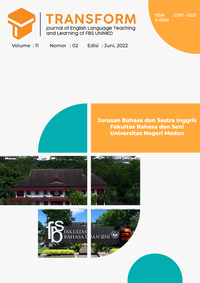Presupposition Analysis of Parhata in Batak Toba Wedding Ceremony
DOI:
https://doi.org/10.24114/tj.v11i2.43992Keywords:
Presupposition, Batak Toba, wedding ceremonyAbstract
This research aims were to describe the types of presupposition used by the Parhata in Batak Toba wedding ceremony and to reveal the realization of presupposition in Parhata™s spoken words in Batak Toba wedding ceremony based on Yule™s framework (2000). In this study the researcher adapted textual analysis (Mc Kee, 2013) to analyze the data. The sources of the data were two videos of wedding ceremonies of Batak Toba. The data were taken from the script of Parhata™s spoken words during the wedding ceremonies. The current research findings showed that the existential presupposition was dominantly used in Parhata™s spoken words. As the mediator and informant in the wedding ceremony, Parhata tended to utter in positive statements. The realization of presupposition types in Parhata™s utterances was recognized according to the theme of presupposition in Yule™s framework. Moreover, the six types of presupposition found in the current research although the findings from wedding ceremony video one and wedding ceremony video two as following; 40 existential presuppositions, five factive presuppositions, two non-factive presuppositions, four lexical presuppositions, one structural presupposition and two counterfactual presuppositions. The realization of presupposition types in Parhata™s utterances was identified by the characteristics of each presupposition, such as mentioning an entity or stating contrary to the fact.Downloads
Published
2023-06-05
Issue
Section
Articles
License
Copyright (c) 2023 Luita Maria Amanda, Anna Riana Suryanti Tambunan

This work is licensed under a Creative Commons Attribution-ShareAlike 4.0 International License.
Authors who publish with this journal agree with the following terms:
- Authors retain copyright and grant the journal right of first publication with the work simultaneously licensed under a Creative Commons Attribution License that allows others to share the work with an acknowledgment of the work's authorship and initial publication in this journal.
- Authors are able to enter into separate, additional contractual arrangements for the non-exclusive distribution of the journal's published version of the work (e.g., post it to an institutional repository or publish it in a book), with an acknowledgment of its initial publication in this journal.
- Authors are permitted and encouraged to post their work online (e.g., in institutional repositories or on their website) prior to and during the submission process, as it can lead to productive exchanges, as well as earlier and greater citation of published work (See The Effect of Open Access).
- This work is licensed under a Creative Commons Attribution-ShareAlike 4.0 International License.

This work is licensed under a Creative Commons Attribution-NonCommercial-ShareAlike 4.0 International License.



